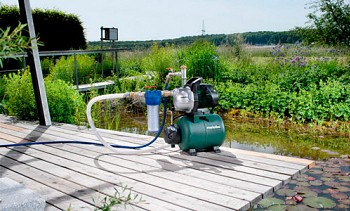How to choose a pumping station for a private house or cottage
Many owners of country houses do not have the opportunity to take advantage of such a civilization benefit as a centralized water supply network. This does not mean at all that the only way out in this situation is to carry water from the nearest source in buckets. Today it is quite possible to equip your own pressure head water supply. The pump station will help you with this, automatically supplying water from a well or well.
Which pumping station to choose for the house? The modern market of pumping equipment offers many options - here are both ready-made stations and individual components, from which, as a designer, you can assemble something that best suits your needs.
The choice must be taken very responsibly so that during the operation of the equipment you do not have any problems.
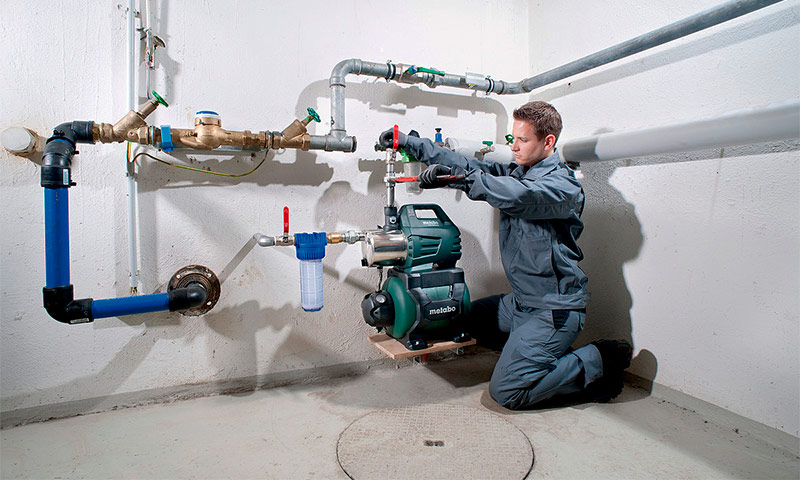
Content:
The device and principle of operation of the pumping station
Does the pumping station differ in anything from a conventional electric pump and, if so, what are its advantages?
Firstly, the pumping station is able to provide the good pressure necessary for the full supply of water to the house and the plot.
Secondly, this system is fully automated and can work without constant monitoring by the owner - it was mounted once, and you can not remember it until the time comes for a routine inspection and verification.
A conscious choice of a pumping station will be impossible if you do not pay due attention to its design and basic components.
The main structural elements of the pumping station are interconnected surface pump and a hydraulic accumulator (pressure tank), as well as an automatic pressure switch that controls the operation of the pump. For the autonomous functioning of the system, this is not enough. But we will talk about the purpose and arrangement of additional components a little later, and now we will focus on the main structural elements.
The device of the pumping station
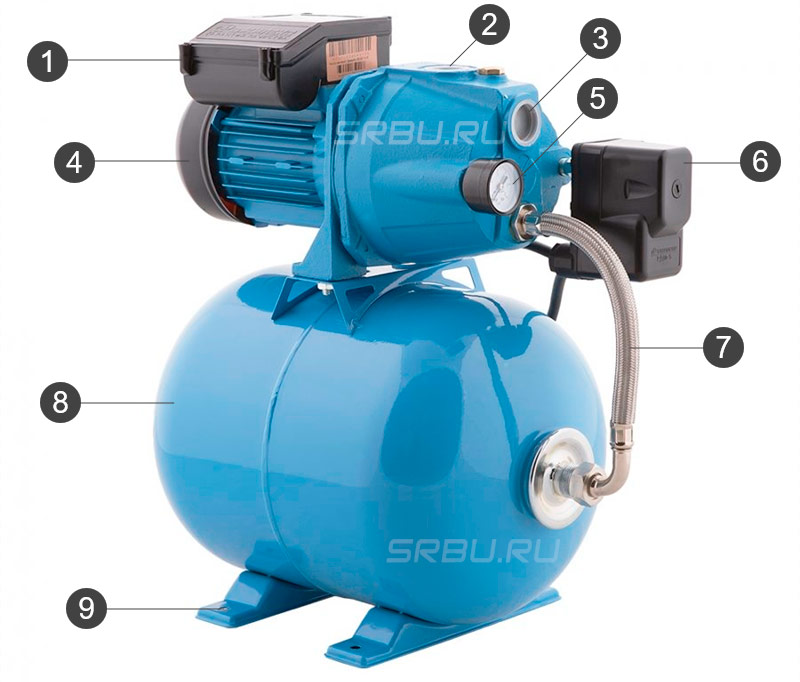
1. Electric block.
2. Outlet fitting.
3. Inlet fitting.
4. Electric motor
5. Pressure gauge.
6. Pressure switch.
7. Hose connecting the pump and receiver.
8. Accumulator
9. Legs for fastening.
The "heart" of the pumping station is the pump. The design type of the pump used can be almost any - vortex, rotary, screw, axial, etc. - but for domestic water supply, as a rule, centrifugal pumps are used, which are distinguished by their simplicity of design and high efficiency.
The second important structural element of the pumping station - the accumulator - is, in fact, a storage tank (which, in fact, follows from its name). However, the purpose of the accumulator is not only the accumulation of injected water.
Without this element, the pump would turn on / off too often - each time the user turns the tap on his mixer. The lack of a hydraulic accumulator would adversely affect the pressure of the water in the system - water would either flow from the tap in a thin stream, or would whip too fast.
How can a pump, a hydraulic accumulator and a pressure switch assembled together automatically supply us with water?
We will understand the principle of the pumping station.
When turned on, the pump starts pumping water, filling the storage tank with it. The pressure in the system gradually increases.The pump will run until the pressure reaches the upper threshold value. When the preset maximum pressure is reached, the relay will trip and the pump will shut down.
What happens when the user opens the faucet in the kitchen or starts taking a shower? Water consumption will lead to a gradual emptying of the accumulator, and therefore to a decrease in pressure in the system. When the pressure drops below the set minimum, the relay will automatically turn on the pump, and it will start pumping water again, compensating for its flow and pumping the pressure to the upper threshold value.
The upper and lower thresholds at which the pressure switch trips are set at the factory. The user, however, has the opportunity to make minor adjustments to the relay. The need for this may arise, for example, if you want to increase the water pressure in the system.
Due to the fact that the pump, which is part of the pumping station, does not work continuously, but only turns on from time to time, equipment wear is minimized.
A short video showing the principle of the pumping station:
Types of pumping stations and distance to the water mirror
Distinguish pumping stations with built-in and remote ejector.The built-in ejector is a structural element of the pump, the remote is a separate external unit, immersed in the well. The choice in favor of one or another option depends primarily on the distance between the pumping station and the water mirror.
From a technical point of view, the ejector is a fairly simple device. Its main structural element - the nozzle - is a pipe with a narrowed end. Passing through the site of narrowing, the water acquires a noticeable acceleration. In accordance with Bernoulli’s law, a region with a low pressure is created around a stream moving at an increased speed, i.e., a rarefaction effect occurs.
Under the influence of this vacuum, a new portion of water from the well is sucked into the pipe. As a result, the pump spends less energy to transport fluid to the surface. The efficiency of pumping equipment increases, as does the depth with which water can be pumped.
Pumping stations with integrated ejector
Built-in ejectors are usually placed inside the pump casing or are located in close proximity to it. This allows you to reduce the overall dimensions of the installation and somewhat simplify the installation of the pumping station.
Such models demonstrate maximum efficiency when the suction height, i.e., the vertical distance from the pump inlet to the level of the water mirror in the source, does not exceed 7-8 m.
Of course, one should also take into account the horizontal distance from the well to the location of the pumping station. The greater the length of the horizontal section, the smaller the depth with which the pump is able to lift water. For example, if the pump is installed directly above the water source, it will be able to raise water from a depth of 8 m. If the same pump is removed from the water intake point by 24 m, the depth of the water rise will decrease to 2.5 m.
In addition to low efficiency at large depths of the water mirror, such pumps have another obvious drawback - increased noise level. To the sound from the vibration of a running pump, the noise of water passing through the nozzle of the ejector is added. That is why it is better to install a pump with a built-in ejector in a separate utility room, outside the residential building.
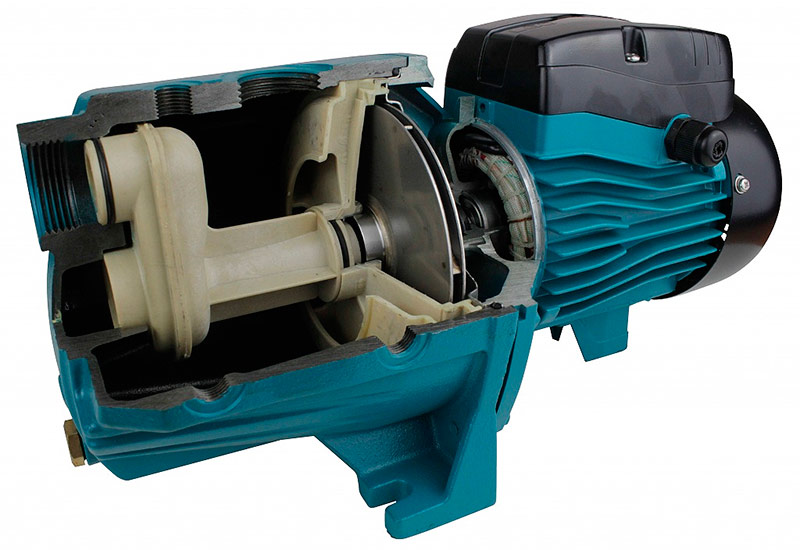
Pump station with integrated ejector.
Pump stations with remote ejector
The remote ejector, which is a separate small block, unlike the built-in ejector, can be located at a considerable distance from the pump - it is connected to the part of the pipeline immersed in the well.
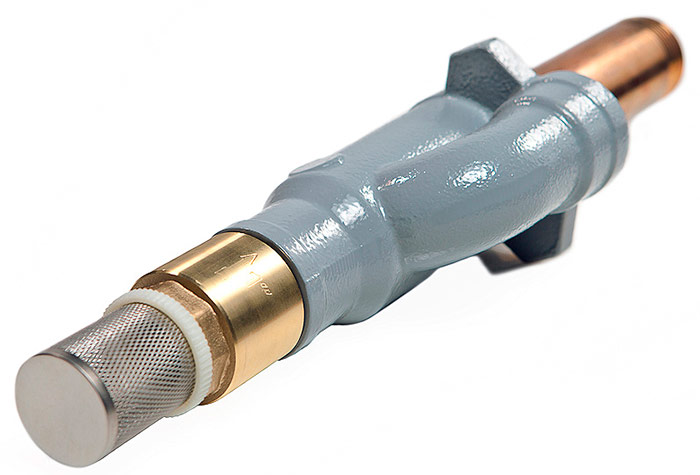
Remote ejector.
A two-pipe system is required to operate a pumping station with a remote ejector. One of the pipes serves to lift water from the well to the surface, along the second part of the raised water it returns down to the ejector.
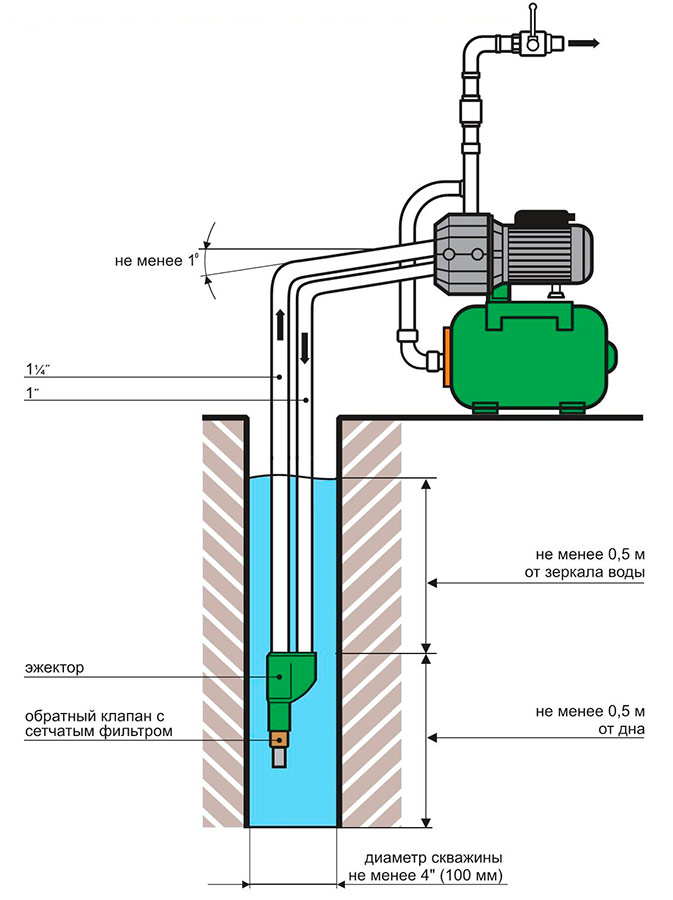
The need to lay two pipes imposes some restrictions on the minimum allowable diameter of the well, it is better to foresee this even at the design stage of the device.
Such a constructive solution, on the one hand, allows you to significantly increase the distance from the pump to the water mirror (from 7-8 m, like for pumps with built-in ejectors, to 20-40 m), but on the other hand, it reduces the efficiency of the system to 30- 35% However, having the opportunity to significantly increase the depth of water intake, you can easily put up with the latter.
If the distance to the water mirror in your area is not too deep, then there is no need to mount the pump station directly near the source. This means that you have the opportunity to move the pump away from the well without a noticeable decrease in efficiency.
As a rule, such pumping stations are located directly in a residential building, for example, in a basement. This provides an increase in the service life of the equipment and simplification of the system setup and maintenance procedures.
Another undoubted advantage of remote ejectors is a significant reduction in the noise level produced by a working pumping station. The noise of the water passing through the ejector, installed deep underground, will no longer disturb the residents of the house.
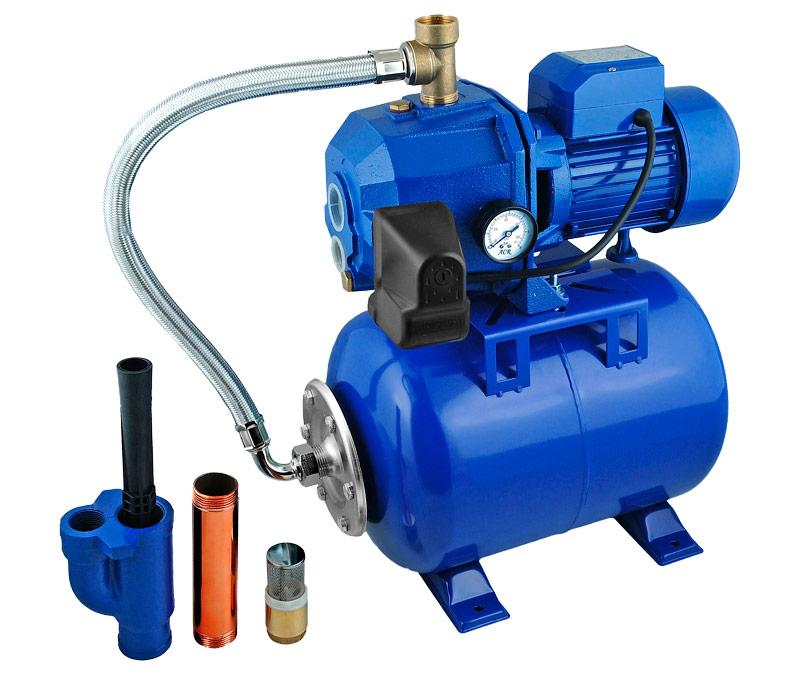
Pump station with remote ejector.
Water consumption, productivity, pressure
Before buying a pumping station, you should understand whether this model is able to satisfy your needs, whether it is able to function normally in the specific conditions you have. This can be estimated by a number of technical characteristics of the pump. Particular attention should be paid to such parameters as the created head (the height to which the pump is able to raise water) and its capacity (the volume of water pumped per unit time).
The total water consumption of the house is the total water consumption by all household appliances (dishwasher and washing machine) and other water taps (taps in the kitchen and bathroom, drains in the bathroom, pool filling, automated irrigation and irrigation systems on the site, etc.).
Ideally, the productivity of the station should be no less than the sum of the costs of all the points of water intake in the house. Only in this case, the residents of the house will not experience problems with the supply of water and its pressure. Only in this case, they will be able to open the tap, without thinking that someone in the house may need water at the moment.
As a rule, sufficiently powerful pumps easily deliver up to 3.5-8 m3 water per hour, maintaining a pressure of 2-3 bar in the water supply network.
To determine the power of the pumping station needed to provide water to all the points of drawdown, three parameters should be evaluated.
1. Firstly, it is necessary to know the height of the feed water, i.e. calculate the distance from the water mirror to the highest point of the water supply.
2. Secondly, it is necessary to take into account the working pressure in the water supply system (for normal operation of household appliances and optimal water pressure in taps, it is required that the pressure be at least 2 bar).
3. Thirdly, it is necessary to evaluate the pressure loss along the entire length of the water supply.
The calculation of water flow and the required pump performance, as well as the selection of a specific pumping station that meets these criteria, is the task of specialists. You are required to determine in advance the distance from the pump intake pipe to the water mirror in the well vertically and the distance of the pump station from the well, to know the type and diameter of the pipes used.
It will not be superfluous to prepare a plan of the site and the house, indicating the location of all points of the drawoff.
There is another important point that should be taken into account before choosing a pumping station for a summer house or home. You pump water from a well or from a well - it doesn’t matter, but the source is full, i.e. its ability to “generate” water should not be less than the productivity of the station.
The flow rate of a well can be found in its passport issued by the drilling organization.
Pump Station Accumulator
The hydraulic accumulator, which is a functionally important node of the pumping station, is a sealed metal container connected to the outlet fitting of the pump.
Accumulator device
Inside the tank there is an elastic membrane wall, usually made of natural rubber or artificial butyl rubber.
The membrane divides the tank into two chambers - air and liquid. A pressure switch coupled to the accumulator determines the pressure of the water in the liquid chamber of the tank and, based on the data received, controls the operation of the pump.
The material for the manufacture of a hydraulic accumulator is traditionally steel. If the membrane has a pear-shaped shape, then water contacts only with it, and, therefore, the possibility of corrosion of the inner walls of the tank is completely excluded.
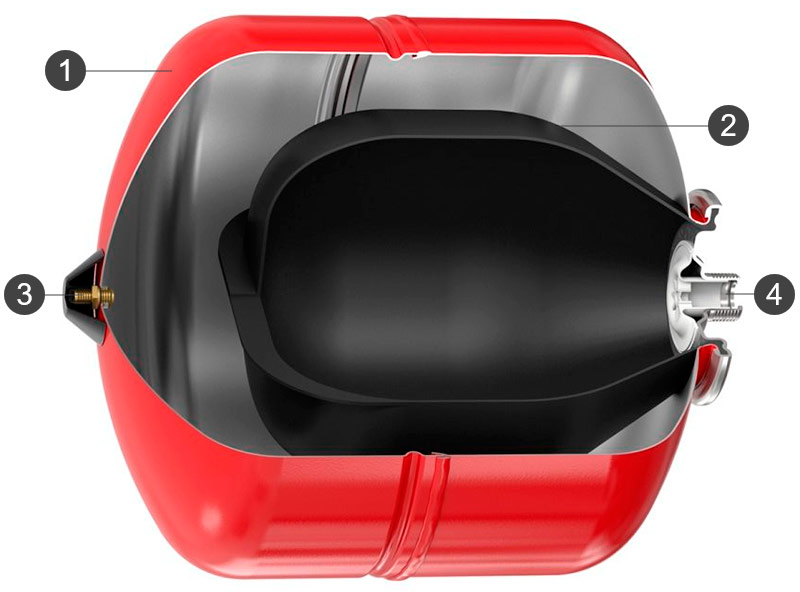
Hydraulic accumulator with a pear-shaped form.
1. Metal tank.
2. Nipple for pumping air.
3. Pear-shaped membrane.
4. The union for connection to the pump.
If a flat membrane is used that separates the tank into two parts, then a protective polymer coating is applied to its metal walls.
Outside, a low-carbon steel tank protects the enamel coating from atmospheric moisture. If it is planned to install a pumping station outside the heated premises, then a stainless steel accumulator should be preferred.
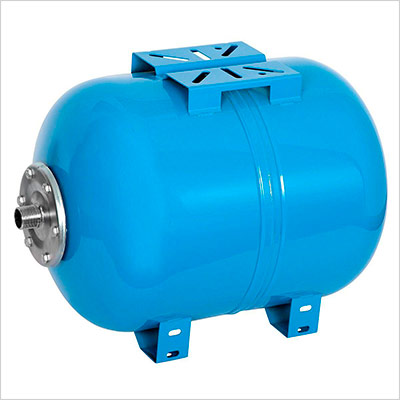
Enamelled low-carbon steel accumulator.
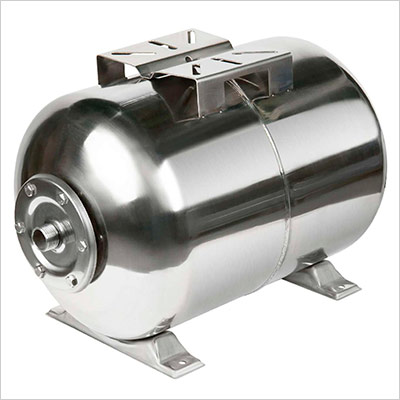
Stainless steel accumulator.
Purpose and principle of operation of the accumulator
The liquid chamber is filled with water, under the influence of the pressure created by it, the elastic partition is deformed. When pressure drops as a result of water flow by users, the membrane straightens, and a new portion of the liquid is ejected from the tank.
Thus, the accumulator ensures the supply of water to the points of drawing even when the pump is not working. Moreover, it limits the number of pump starts. A certain supply of liquid is stored inside the tank, and therefore there is no need to turn on the pump every time you open the tap.
Typically, the flow rate of the accumulator before refilling is half its full volume. For example, from a 20-liter tank, you can safely pump out 10 liters of water, without turning on the pump. And the less often the latter turns on, the longer it will last.
Some surface pumps allow a high frequency of starts - up to 30-100 times per hour. However, frequent starts / stops significantly reduce the life of the electric motor - the resource of individual components of the device is developed prematurely. An ideal option from this point of view is when the number of pump on / offs does not exceed 10-20 times a day.
The hydraulic accumulator not only creates pressure in the water supply network of the house, serves as a limiter for the number of intermittent pump starts, and stores a supply of water. It also allows you to avoid hydraulic shocks - sharp pressure surges in the system.
How to choose the volume of the accumulator
The volume of the accumulator can vary, depending on the model, from 8 to 100 or more liters. The choice of tank size depends on the total water consumption, well depth, pipeline length and pump parameters. Together with pumps with a capacity of up to 1.2 kW, it is recommended to use hydraulic accumulators with a capacity of 20-24 liters, for pumps with a capacity of 1.5-2 kW, tanks of 50-60 liters are more suitable.
What volume can be considered optimal? The more, the better, but to certain limits. Theoretically, the larger the accumulator volume, the more reliably the pump is protected from frequent starts. However, practice shows that increasing the volume of the tank to 100-200 l very often leads to a decrease in the comfort of using the water supply: the user is forced to put up with the fact that the pressure of the water flowing from the tap is gradually reduced.
Users who have extensive experience in operating pumping stations are unanimous in the opinion that the most convenient accumulator in the volume of 16-24 liters. It should be borne in mind that, if necessary, you can always connect an additional accumulator of the required volume to the water main.
Material of manufacture of the pump and its structural elements
The main disadvantage of centrifugal pumps is their high demands on the purity of the pumped water. Sand grains, sludge and other solid particles entering the inside cause premature wear of the pump parts.
The service life of equipment largely depends on the material of which the impeller is made. Stainless steel impellers are more durable, but are more expensive than plastic products, often installed in household models.
Various materials are also used to make the pump casing.
1. Pumps in plastic housings are the cheapest and most importantly the quietest. At the same time, such pumps do not differ in reliability.
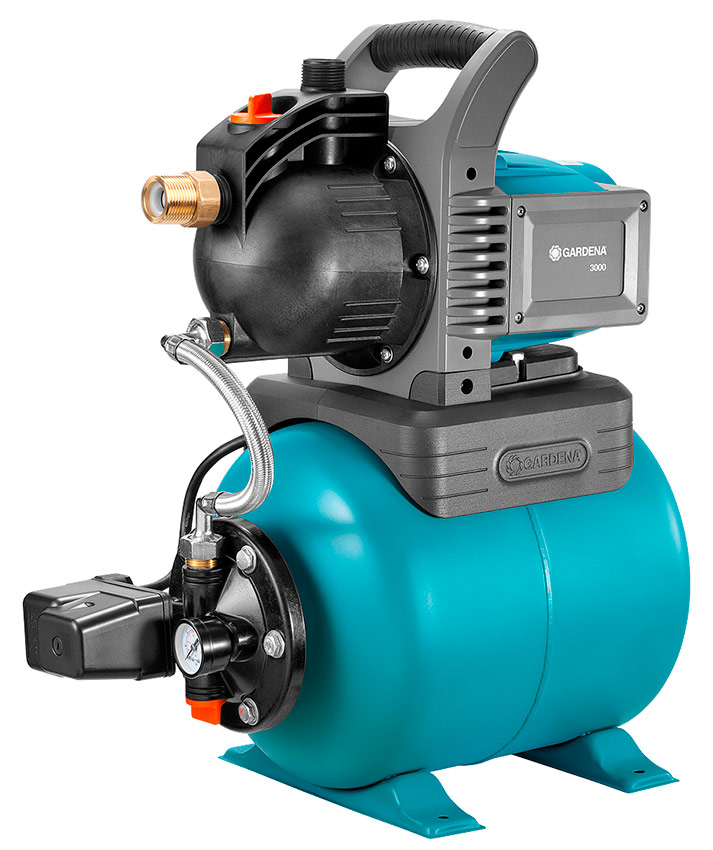
2. Steel, on the contrary, is the most expensive and noisy, but at the same time the most durable.
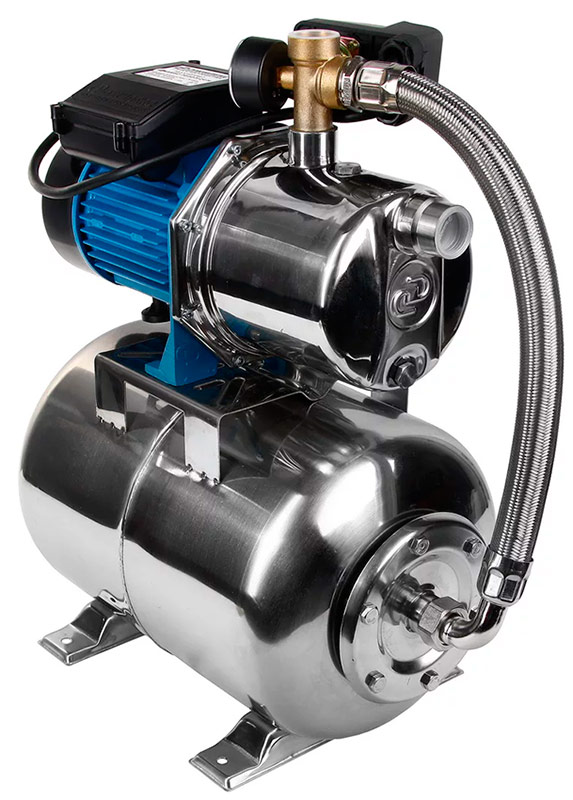
3. Cast iron in all respects occupy an intermediate position.
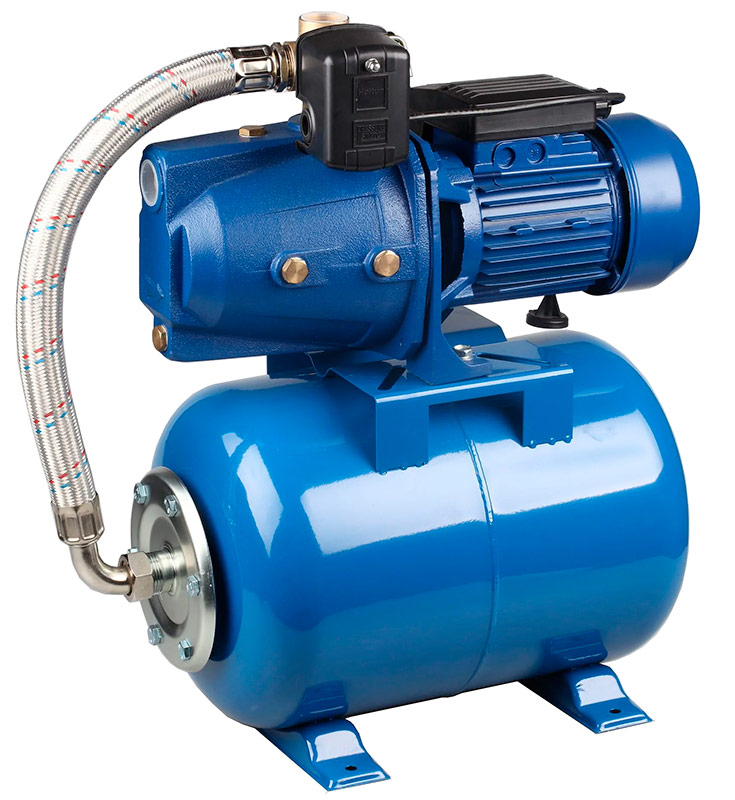
In addition to the manufacturing material of the pump housing and its impeller, when selecting, it is worth paying attention to one more parameter, namely, the material of the motor winding. Often, to reduce the cost and facilitate the design, an aluminum winding is used.
Alas, it is less durable than copper, which negatively affects the overall reliability of the pump, forced to work year-round and almost around the clock.
Control automation
The main difference between pumping stations and pumps is the availability of equipment that allows them to work without constant monitoring by humans. Under the control automation is primarily meant a pressure switch. This unit automates the operation of the pump, turning it on and off at certain extreme pressure values in the system.
Most pumping stations are equipped with mechanical (spring) pressure switches. This is a small-sized device, inside which all the necessary working elements are located - two different-sized springs with adjusting nuts, electrical contacts, a membrane and a plate that changes its position depending on the pressure on it from the side of the membrane.
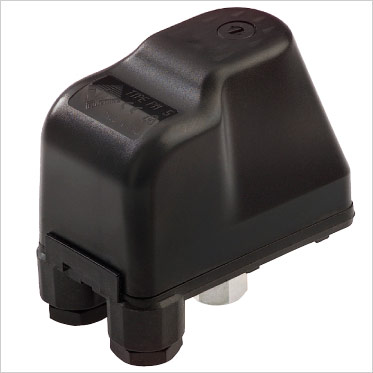
Relay Assembly
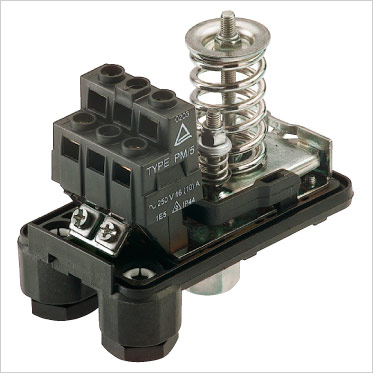
Relay with cover removed.
Under the pressure of the water entering the accumulator, the membrane is deformed and displaces the plate, which, in turn, begins to act on a large spring. Compression of the spring leads to the opening of the contact that supplies voltage to the pump motor.
When the pressure decreases as a result of water consumption by the consumer, the plate returns to its original position, the contacts close, and the pump starts working again. A large spring creates resistance to water pressure on the membrane and plate, a small one sets the difference between the lower and upper pressure thresholds.
The upper and lower pressure limits are set at the factory, however, if necessary, you can manually reconfigure both the upper and lower thresholds. The compression force of the springs is changed by means of the corresponding adjusting nuts.
The mechanical relay can be replaced by an electronic one. The latter is not power, it interacts with the automation of the station and already through it affects the operation of the pump. The functionality of an electronic relay is, of course, richer than that of a mechanical one. Some models, for example, are equipped with an hourly timer that limits the number of pump starts per unit time.
As a rule, electronic models of relays are equipped with indicators and a control panel, through which the parameters are adjusted.
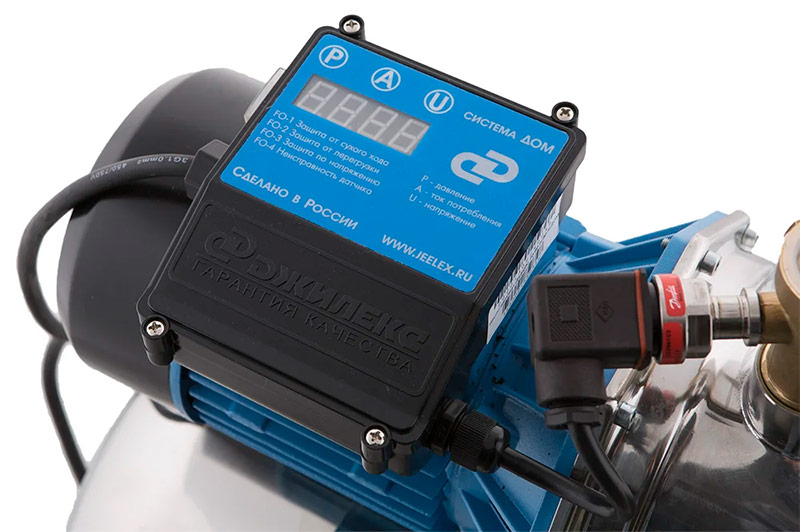
Pump station with electronic relay.
Optional equipment
In addition to the electric pump, hydraulic accumulator and control automation, any pump station must include:
- connecting fittings, including flexible hoses connecting the pump to the accumulator;
- a manometer that measures the pressure of the liquid in the system and facilitates monitoring of the operation of the pump,
- non-return valve that prevents emptying of the supply line when the pump is turned off;
- filters preventing mechanical impurities from entering the pump;
- automatic circuit breakers for the pump.
Filters
Centrifugal pumps are characterized by increased demands on the purity of the pumped liquid. It is very important that the water passing through the pump does not contain abrasive particles (silt, sand, etc.), as well as long-fiber inclusions with linear dimensions of more than 2 mm (algae, blades of grass, slivers).
The maximum permissible amount of mechanical impurities is considered to be 100 g / m3. To protect the pump from failure and its individual components from premature wear as a result of pumping water containing foreign inclusions, a coarse mesh filter will help.
It is mounted at the end of the intake pipe and cuts off large debris floating in the water column or on its surface.
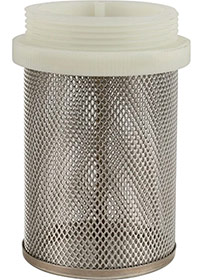
After the station, fine-filtering filters are installed that clean the water, which is sent to the consumer. However, they have nothing to do with the pumping station.
Check valve
In order for the pump to be able to start pumping water at any time, it is necessary that the supply line is always full. That is why the water intake system of the pumping stations is equipped with a non-return valve installed immediately after the coarse strainer.
The presence of a check valve eliminates the need to wait a long time each time until the water rises into the pump from the well, and, more importantly, saves the pump from working in the “dry” start-up mode, which could lead to equipment failure.
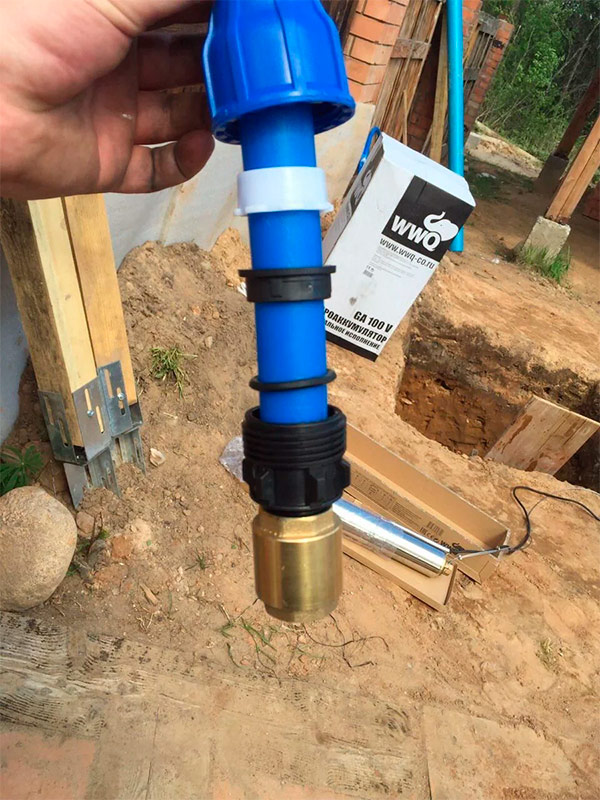
Water pipe with non-return valve.
Protective automation
Our power networks cannot boast of stability, and voltage often “walks” over a fairly wide range. Protecting expensive equipment from power surges will help the residual current circuit breaker. If this component is not included in the package of your station, it can (and must!) Be purchased separately. It will not be superfluous and the circuit breaker when the pump overheats.
The dry running protection system is another element that is necessary to extend the life of the pumping station. It is especially important in cases where the well productivity is variable. A sensor located in the well will signal to turn off the pump as soon as the water level falls below the minimum limit. This will prevent overheating and failure of the pump due to air pumping.

